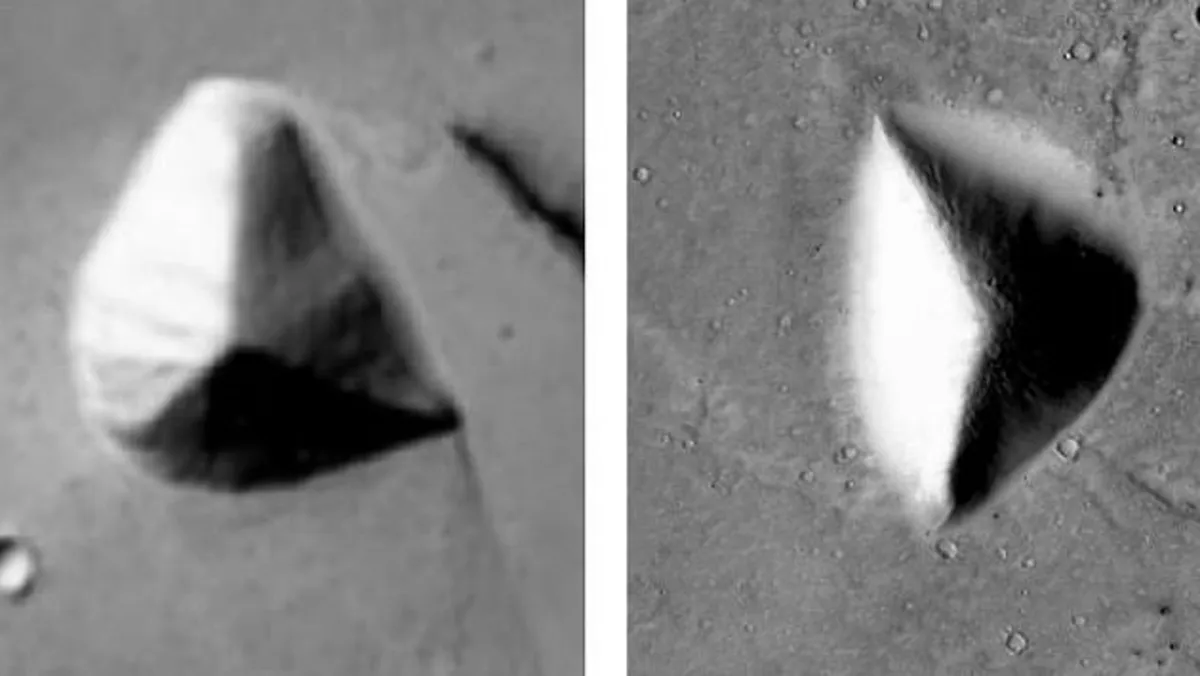
The surface of Mars may initially appear as an empty red wasteland, but a closer examination reveals potential remnants of an ancient alien civilization. This bold assertion comes from George J. Haas, the founder and lead investigator of The Cydonia Institute, a research group dedicated to analyzing Martian structures. In his new book, 'The Great Architects of Mars', Haas meticulously reviews numerous photographs of what he believes are man-made structures on the Martian surface, including pyramids, keyhole formations, and even shapes resembling a parrot.
Haas, who has dedicated over 30 years to studying NASA images of Mars, argues that the presence of geometric patterns and features indicates intelligent design rather than random geological formations. As a formally trained artist, he claims to possess a unique understanding of the distinctions between naturally occurring shapes and those that are deliberately crafted. He stated, “You don't have to be a geologist to know the difference between a rock and a sculpture — something that's geometric,” in an interview with DailyMail.com.
Despite Haas's claims, many scientists contest his conclusions, suggesting that they stem from pareidolia, a psychological phenomenon where individuals perceive familiar patterns, such as faces, in random stimuli. Robin Kramer, a Senior Lecturer in the School of Psychology at the University of Lincoln, explained, “Sometimes we see faces that aren't really there,” emphasizing that this cognitive bias can lead to misinterpretations of natural formations.
One of Haas's primary focuses is the keyhole-shaped formation located in Libya Montes, captured by NASA's Mars Reconnaissance Orbiter (MRO) in 2011. This unique structure comprises two main components: a wedge-shaped formation and a circular dome, together resembling an enormous exclamation mark. Haas describes this formation as a keyhole, stating that its geometric precision suggests it could have been intentionally constructed. In 2016, he and his colleagues published an analysis in the Journal of Space Exploration, arguing that the formation’s symmetry and geometry are too complex to be explained by natural processes alone.
Another intriguing formation is the so-called parrot geoglyph, discovered in 2002 by researcher Wilmer Faust within the Argyre Basin. The geoglyph appears to depict a parrot, complete with anatomical details such as a head, eye, beak, body, and wing. Haas asserts that this formation stands out due to its rich detail, unlike typical pareidolic images. He claims that five veterinarians, including an avian specialist, confirmed the lifelike quality of the parrot’s anatomy. While geoglyphs are found across Earth, Haas argues that none match the intricate detail observed in this Martian structure.
In 1972, NASA’s Mariner 9 spacecraft captured images of triangular pyramids in Mars' Elysium region. These formations, with an average height of over 3,200 feet, have drawn comparisons to Earth's largest pyramids. Renowned astronomer Carl Sagan speculated these shapes might arise from natural erosion processes. However, Haas suggests that intelligent beings could have built them, especially given recent findings indicating the region may have supported ancient life.
The Atlantis Chaos region in Mars' southern hemisphere presents another captivating case. Initially thought to be eroded terrain, some researchers, including Greg Orme, have suggested that it contains a grid of cellular formations reminiscent of urban landscapes. Haas notes that these arrangements resemble city ruins on Earth, such as mudbrick homes in the Midwest and bombed-out areas of Berlin, supporting the theory of an ancient civilization.
Haas has also identified a peculiar star-shaped formation in the Nepenthes Mensae region of Mars, which he named the Starburst. This structure bears similarities to star forts constructed in Europe and America during the 16th and 17th centuries. Haas argues that the design of the Starburst closely resembles that of Fort Henry, highlighting the potential for ancient military or communal architecture on Mars.
Haas's findings pose significant questions about the origins of these structures. To validate his claims regarding an ancient alien civilization, scientists will need to conduct closer examinations of these formations. As space exploration advances, the prospect of humans landing on Mars may soon become a reality. With ambitions from space pioneers like Elon Musk, who plans to launch an uncrewed mission by 2026 and send astronauts by 2029, the opportunity to investigate these enigmatic structures could be on the horizon. Haas perceives Mars as a “treasure trove of technology and information,” waiting to be uncovered.